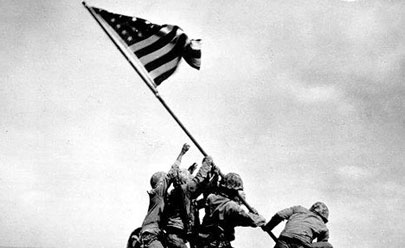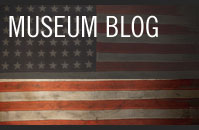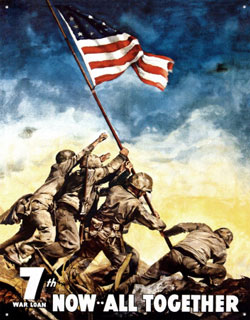FOCUS ON: THE BATTLE FOR IWO JIMA:

After months of naval and air bombardment, US Marines invaded Iwo Jima on February 19, 1945. The Japanese defenders of the island were dug into bunkers deep within the volcanic rocks.
While the battle was still raging, captured airstrips were already being repaired by the Seabees and put into use as emergency landing sites for damaged B-29s. They would continue to be used for that purpose once the island was captured—accommodating more than 2,200 B-29 bombers, saving the lives of 24,000 U.S. airmen—but the airstrips functioned primarily as a base for long-range fighter escorts supporting the strategic bombing of mainland Japan.
Before the island was declared secured on March 16, 1945, US Marines suffered 22,056 casualties and the US Navy suffered 2,798 over 36 days of fighting. Of 22,000 total Japanese casualties, 216 were captured by the Marines; the rest were killed in action. Notably, this was the only battle in which American casualties outnumbered those incurred by Japan. It was also one of the bloodiest battles in Marine Corps history.
The famous flag-raising atop Mt. Suribachi took place on February 23, 1945, five days after the battle began. Associated Press photographer Joe Rosenthal took the iconic photograph of Corporal Harlon Block, Private First Class Harold Schultz, Corporal Rene Gagnon, Private First Class Franklin Sousley, Sergeant Michael Strank, and Corporal Ira Hayes. Three of these men—Strank, Sousley, and Block—were killed before the battle for Iwo Jima was over. Rosenthal's photograph, which was quickly wired around the world and reproduced in newspapers across the United States, later served as a model for the United States Marine Corps Memorial at Arlington National Cemetery, and remains one of the war's most enduring images.
Note: Schultz’s participation in the flag raising and iconic photo was not officially recognized until June 2016, when the US Marine Corps announced that Navy Pharmacist Mate 2nd Class John Bradley had long been incorrectly identified as one of the men in the image captured by Rosenthal. Historian and author Richard Frank addressed the context in which such a misidentification could occur in an essay for The National WWII Museum’s online blog:
Ultimately, as the Marine Corps Commandant correctly affirmed, “It’s not about the individuals and never has been.” It is impossible to distinguish the faces of any of the flag raisers in the image. The power of the image is and always will be the stunning symbolism of collective effort and valor.
Iwo Jima Oral History: Woody Williams, Medal of Honor Recipient

Woody Williams Medal of Honor citation:
Woody Williams Medal of Honor citation:
The President of the United States takes pride in presenting the MEDAL OF HONOR to CORPORAL HERSHEL W. WILLIAMS UNITED STATES MARINE CORPS RESERVE for service as set forth in the following CITATION: For conspicuous gallantry and intrepidity at the risk of his life above and beyond the call of duty as Demolition Sergeant serving with the First Battalion, Twenty-First Marines, Third Marine Division, in action against enemy Japanese forces on Iwo Jima, Volcano Island, 23 February 1945. Quick to volunteer his services when our tanks were maneuvering vainly to open a lane for the infantry through the network of reinforced concrete pillboxes, buried mines and black, volcanic sands, Corporal Williams daringly went forward alone to attempt the reduction of devastating machine-gun fire from the unyielding positions. Covered only by four riflemen, he fought desperately for four hours under terrific enemy small-arms fire and repeatedly returned to his own lines to prepare demolition charges and obtain serviced flame throwers, struggling back, frequently to the rear of hostile emplacements, to wipe out one position after another. On one occasion he daringly mounted a pillbox to insert the nozzle of his flame thrower through the air vent, kill the occupants and silence the gun; on another he grimly charged enemy riflemen who attempted to stop him with bayonets and destroyed them with a burst of flame from his weapon. His unyielding determination and extraordinary heroism in the face of ruthless enemy resistance were directly instrumental in neutralizing one of the most fanatically defended Japanese strong points encountered by his regiment and aided in enabling his company to reach its' objective. Corporal Williams' aggressive fighting spirit and valiant devotion to duty throughout this fiercely contested action sustain and enhance the highest traditions of the United States Naval Service.
Additional Resources


Items from the Museum Store

Iwo Jima Metal Sign
Price: $20.00


